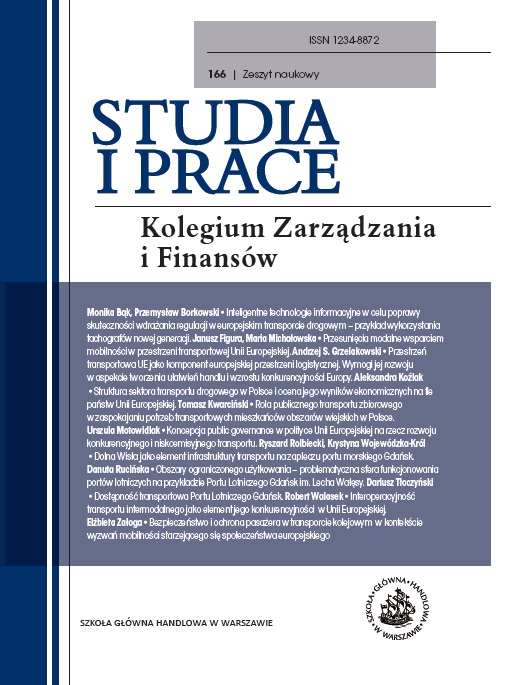Role of Public Transport in Meeting Transport Needs of Rural Population in Poland
DOI:
https://doi.org/10.33119/SIP.2018.166.5Keywords:
public transport, rural areas, transport needsAbstract
The paper makes an attempt to assess the role of public transport in meeting transport demand and needs of people living in rural areas. One needs to stress the importance of public transport, in particular to people whose access to private cars is limited or who, for other reasons, cannot use private cars to satisfy their transport needs.
Scarcely built up rural areas with relatively small number or residents and low population density represent lower demand for transport services than urban areas. Besides, demand for transport services in these areas is scattered due to rather loose settlement pattern. In rural areas we can observe social and economic changes which impact the scale and structure of transport needs. We need to bear in mind the decreasing trend in the number of people working in agriculture. The process provides an impulse to higher mobility of persons also because society is increasingly more wealthy. Demographic changes are also relevant not only in rural areas but across the entire country: aging society which impacts transport needs of residents.
The scale and scope of transport needs in rural areas vary. To some people rural areas are not destinations where they work, go to school, meet their demand for healthcare services or do shopping. On the other hand, not all of these needs can be fully met in rural areas. Such limitations are valid premises why they are seeking to have these needs met in other areas (mainly urban), which entails travelling. Public transport, as confirmed by studies discussed in the paper, is an important determinant of meeting social and economic needs of people living in rural areas. These needs are properly met when it comes to public transport connected with work and going to school. From the perspective of types of needs examined in the paper, transport services connected with doing shopping and healthcare are rather poor.
Downloads
References
2. Dojazdy do pracy w 2010 roku na podstawie BAEL. Warszawa: GUS.
3. Koźlak, A. (2008). Ekonomika transportu: teoria i praktyka gospodarcza. Gdańsk: Wyd. UG.
4. Kwarciński, T. (2016). Dostępność publicznego transportu zbiorowego na obszarach wiejskich w Polsce. Szczecin: Wydawnictwo Naukowe US.
5. Ludność stan i struktura w przekroju terytorialnym (2017). Warszawa: GUS.
6. Obszary wiejskie w Polsce w 2014 r. (2016). Warszawa: GUS.
7. Oświata i wychowanie w roku szkolnym 2010/2011 (2011). Warszawa: GUS.
8. Oświata i wychowanie w roku szkolnym 2016/2017 (2017). Warszawa: GUS.
9. Rocznik statystyczny Rzeczypospolitej Polskiej 2017 (2017). Warszawa: GUS.
10. Taylor, Z. (1997). Dostępność miejsc pracy, nauki i usług w obszarach wiejskich jako przedmiot badań geografii społeczno-ekonomicznej – próba analizy krytycznej. Przegląd Geograficzny, t. 69, nr 3–4.
11. Tyszka, S., Solon-Lipiński, M. (2013). Stan zdrowia ludności wiejskiej w Polsce. Warszawa: Forum Inicjatyw Rozwojowych.
12. Ustawa z dn. 07.09.1991 r. o systemie oświaty, Dz. U. 2016, poz. 1943.









